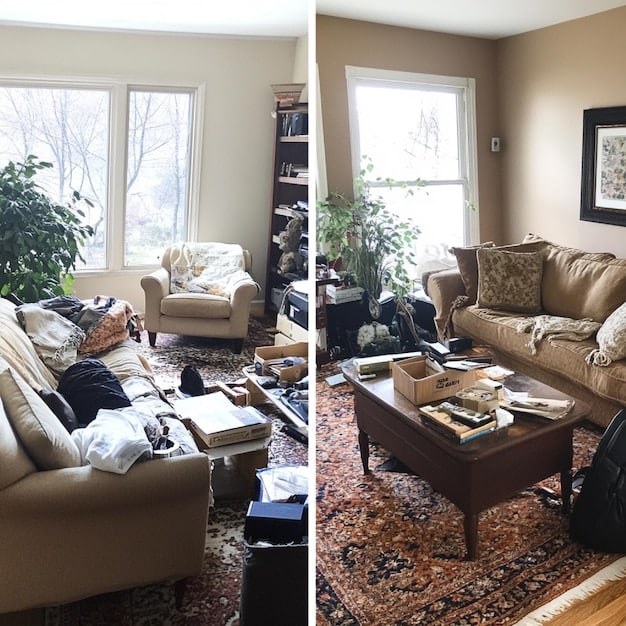Chaos to Calm: A Mom’s Guide to Peaceful Home & Self-Care

Creating a peaceful home environment is essential for a mom’s self-care, involving decluttering, designating personal spaces, establishing routines, and practicing mindfulness to reduce stress and enhance well-being.
Navigating the beautiful chaos of motherhood often leaves little room for personal peace. This guide, **From Chaos to Calm: A Mom’s Guide to Creating a Peaceful Home Environment for Self-Care**, offers practical strategies to transform your home into a sanctuary.
Understanding the Need for a Peaceful Home
A hectic home life can significantly impact a mother’s mental and emotional well-being. Constant noise, clutter, and demands can lead to stress, anxiety, and burnout. Creating a peaceful home environment is not a luxury but a necessity for self-care.
This section explores the reasons why a calm home is crucial and sets the stage for practical strategies to achieve it.
The Impact of a Chaotic Home on Mom’s Well-being
A chaotic home environment often results in increased stress levels for moms. Studies have shown a direct correlation between stressful home environments and increased cortisol levels, indicating a physiological stress response.
The lack of a tranquil space can lead to chronic fatigue, irritability, and difficulty concentrating, making it hard to manage daily tasks efficiently.
Benefits of a Calm and Organized Space
Conversely, a calm and organized home can foster a sense of control and serenity. Mothers who have a peaceful home report lower stress levels, improved mood, and enhanced ability to focus on both their children and their own needs.
A well-organized space can also save time and energy, reducing the mental load associated with managing a household.
- Reduced stress and anxiety
- Improved mood and emotional stability
- Increased productivity and focus
- Enhanced self-care practices
Prioritizing the creation of a serene home is an investment in mental and emotional wellness, positively affecting both the mother and the rest of the family.
Decluttering: The First Step to a Serene Home
Decluttering is more than just tidying up; it’s a process of simplifying your surroundings to reduce visual noise and mental clutter. This foundational step paves the way for a more peaceful home environment.
We’ll explore practical techniques and tips for decluttering effectively, creating a space that supports relaxation and well-being.

Effective Decluttering Techniques
One popular decluttering technique is the KonMari Method, which encourages you to keep only items that “spark joy.” This involves categorizing possessions and deciding whether each item aligns with your values and brings positive emotions.
Another effective approach is the “20-minute declutter,” where you dedicate a short amount of time each day to tackling one small area. Consistency can lead to significant progress over time.
Tips for Maintaining a Clutter-Free Home
Maintaining a clutter-free home requires establishing habits and routines. One useful strategy is the “one-in, one-out” rule, where for every new item you bring into the house, you remove a similar item.
Regularly assess your belongings and donate or discard items you no longer need or use, keeping only what adds value to your life.
- Start small and focus on one area at a time
- Use clear storage containers to organize items
- Involve the whole family in the decluttering process
- Set aside time each week for a quick tidy-up
By implementing these techniques and tips, you can create a clutter-free home that promotes relaxation and reduces stress.
Creating Designated Self-Care Spaces
Having a specific area dedicated to self-care can make a significant difference in your ability to recharge and rejuvenate. This space acts as a personal sanctuary where you can retreat from the demands of daily life.
This section provides insights on how to identify and optimize spaces in your home for self-care, ensuring they support your well-being.
Identifying Potential Self-Care Zones
Consider underutilized areas in your home, such as a quiet corner in the bedroom, a sunny spot by the window, or even a small section of your garden. These can be transformed into self-care zones.
Think about activities you enjoy and the kind of atmosphere that helps you relax. A cozy reading nook, a meditation space, or an art corner could be potential self-care zones.
Optimizing Spaces for Relaxation and Rejuvenation
Personalize your self-care zone with elements that promote relaxation and well-being. Soft lighting, comfortable seating, calming colors, and natural elements can enhance the ambiance.
Add items that support your self-care activities, such as books, yoga mats, art supplies, or essential oil diffusers. Create a space that invites you to relax and recharge.
- Choose a location with natural light and ventilation
- Add plants or flowers to bring nature indoors
- Use soft textiles such as blankets and pillows
- Incorporate items that appeal to your senses
By identifying and optimizing spaces for self-care, you can create havens within your home that support emotional and mental well-being.
Establishing Calming Routines
Routine is a cornerstone of peace of mind, especially for mothers. Establishing habits to keep the home in order and create a predictable rhythm can work wonders.
This section delves into the importance of routines and offers tips for establishing routines that foster calm and provide respite.

Morning and Evening Rituals for Peace
Start the day with a calming morning routine, such as a brief meditation, a cup of tea, or gentle stretching. Avoid checking emails or social media immediately, focusing instead on setting a positive tone for the day.
End the day with an evening ritual that promotes relaxation, such as a warm bath, reading a book, or practicing gratitude. These rituals signal to your body that it’s time to unwind.
Routines for Household Chores and Meal Prep
Streamline household chores by creating a schedule that breaks down tasks into manageable chunks. Dedicate specific days for laundry, cleaning, and grocery shopping.
Meal prepping can also reduce stress during the week. Spend a few hours on the weekend preparing meals or components, making it easier to put together healthy dinners.
- Set realistic expectations and be flexible
- Involve family members in the routines
- Use visual cues, such as checklists or calendars
- Reward yourself for sticking to the routine
By establishing calming routines, you can create a sense of order and predictability that fosters peace.
Incorporating Mindfulness and Meditation
Mindfulness techniques offer a powerful way to reduce stress and enhance self-awareness. By practicing mindfulness, you can train your mind to focus on the present moment and let go of worries and distractions.
This section provides insights on how to incorporate mindfulness and meditation into your daily life, even amidst the chaos of motherhood.
Simple Mindfulness Exercises
Start with simple mindfulness exercises, such as mindful breathing, where you pay attention to the sensation of each breath. Focusing on the breath can help anchor you in the present moment.
Another exercise is mindful eating, where you savor each bite of food, paying attention to the taste, texture, and aroma. This can enhance your enjoyment of meals and reduce overeating.
Guided Meditation for Busy Moms
Guided meditation apps offer a convenient way to practice meditation, even if you have limited time. These apps provide sessions tailored to different needs, such as stress reduction, sleep improvement, and emotional balance.
Schedule short meditation sessions into your day, even if it’s just for five or ten minutes. Consistency can lead to significant benefits over time.
- Find a quiet space where you won’t be disturbed
- Use headphones to block out external noise
- Start with short sessions and gradually increase the duration
- Be patient with yourself and don’t judge your thoughts
By incorporating mindfulness and meditation into your routine, you can cultivate inner peace and resilience.
Delegate and Ask for Help
Mothers often take on too much, leading to overwhelm and burnout. Learning to delegate tasks and ask for help is essential for self-care and creating a more balanced home life.
This section encourages moms to recognize the importance of seeking support and offers practical tips for delegating tasks effectively.
Identifying Tasks to Delegate
Start by identifying tasks that can be delegated to other family members or outsourced. Household chores, errands, and childcare responsibilities can be shared.
Consider hiring a cleaning service, a babysitter, or a meal delivery service to alleviate some of your workload. Small investments can make a significant difference in your stress levels.
Communicating Needs and Boundaries
Communicate your needs and boundaries clearly to your family. Let them know what you need help with and how they can support you. Set realistic expectations and be willing to negotiate.
Don’t be afraid to ask for help from friends, neighbors, or community resources. Many organizations offer support services for families and mothers.
- Create a chore chart or assign tasks to family members
- Use technology to automate tasks, such as online bill payment
- Be specific about your needs and expectations
- Express gratitude for their support
By delegating tasks and asking for help, you can create a more supportive and balanced home environment.
Embracing Imperfection and Practicing Self-Compassion
Striving for perfection can lead to unnecessary stress and self-criticism. Embracing imperfection and practicing self-compassion are essential for maintaining a positive mindset and nurturing your well-being.
This section encourages mothers to let go of unrealistic expectations and treat themselves with kindness and understanding.
Letting Go of Unrealistic Expectations
Recognize that it’s impossible to do everything perfectly. Let go of the pressure to be a supermom and embrace the idea that good enough is often sufficient. Focus on what truly matters and let go of the rest.
Challenge your inner critic and replace negative thoughts with positive affirmations. Remind yourself of your strengths and accomplishments.
Practicing Self-Compassion
Treat yourself with the same kindness and understanding that you would offer a friend. Acknowledge your struggles and validate your feelings.
Engage in activities that bring you joy and relaxation, such as spending time in nature, listening to music, or pursuing a hobby. Prioritize self-care and make time for activities that nourish your soul.
- Forgive yourself for mistakes and shortcomings
- Focus on progress rather than perfection
- Celebrate small victories and accomplishments
- Surround yourself with supportive and positive people
By embracing imperfection and practicing self-compassion, you can cultivate a more positive and resilient mindset.
| Key Point | Brief Description |
|---|---|
| 🧹 Declutter | Remove unnecessary items to reduce visual noise and mental clutter. |
| 🧘 Self-Care Space | Designate and personalize a space for relaxation and rejuvenation. |
| 🗓️ Routines | Establish calming morning and evening rituals and routines for household chores. |
| 🙏 Mindfulness | Incorporate mindfulness and meditation to reduce stress and enhance self-awareness. |
FAQ
▼
A peaceful home reduces stress, improves mood, and enhances focus, enabling moms to better manage daily tasks and prioritize self-care, leading to greater overall well-being.
▼
Begin by decluttering one small area at a time, such as a drawer or shelf. Use techniques like the KonMari Method or the “20-minute declutter” for effective results.
▼
Try mindful breathing, focusing on each breath, or mindful eating, savoring each bite. These simple exercises can anchor you in the present moment and reduce stress.
▼
Identify tasks that can be delegated to family members or outsourced. Communicate your needs clearly and set realistic expectations. Use chore charts or assign tasks.
▼
Self-compassion helps moms let go of unrealistic expectations and treat themselves with kindness and understanding. It promotes a positive mindset and enhances overall well-being.
Conclusion
Creating a peaceful home environment is an ongoing journey that requires dedication and self-compassion. While the path may sometimes feel chaotic, implementing strategies such as decluttering, creating designated self-care spaces, establishing calming routines, and practicing mindfulness can lead to a more serene and balanced life for you and your family. Remember, small steps and consistent effort can transform your home into a haven of peace.





